apparently in the form of

*
Plate I
Cliff in Stem Cove, showing low dip of shear-planes, resembling beds.
cropped, original orientation retained
illustrating Clement Reid, J. B. Scrivenor, et al. The geology of the country near Newquay. Memoirs of the Geological Survey. England and Wales. (Explanation of Sheet 346). London 1906
University of Michigan copy, digitized 30 January 2009
In Plates 1 and 2 this relation of cleavage to bedding is well illustrated. The high cliff, seen in Plate 1, seems at first sight to be formed of evenly bedded rock with a gentle seaward dip. The fallen block shown in Plate 2, proves, however, that this even bedding is really cleavage, cutting through a system of sharp folds, here indicated by a faint colour-stripe...
The contortion, however, though masking the anticlinal structure, does not obliterate it.
Subsequent to the formation of the structures just described, or perhaps during their formation, the granite was intruded among the sedimentary strata, apparently in the form of laccolites or subterranean lakes of molten rock. Still later, and probably while part of the granite was yet fluid, long fissures were formed, and filled with material differing but little from, and apparently derived from, the still fluid part of the granite. These are the "elvan" dykes, which cut both granite and slate...
p 3
28 December 2013
tags: C. Reid; J. B. Scrivenor; contortions; elvan dykes; forms; obliterations; subterranean lakes